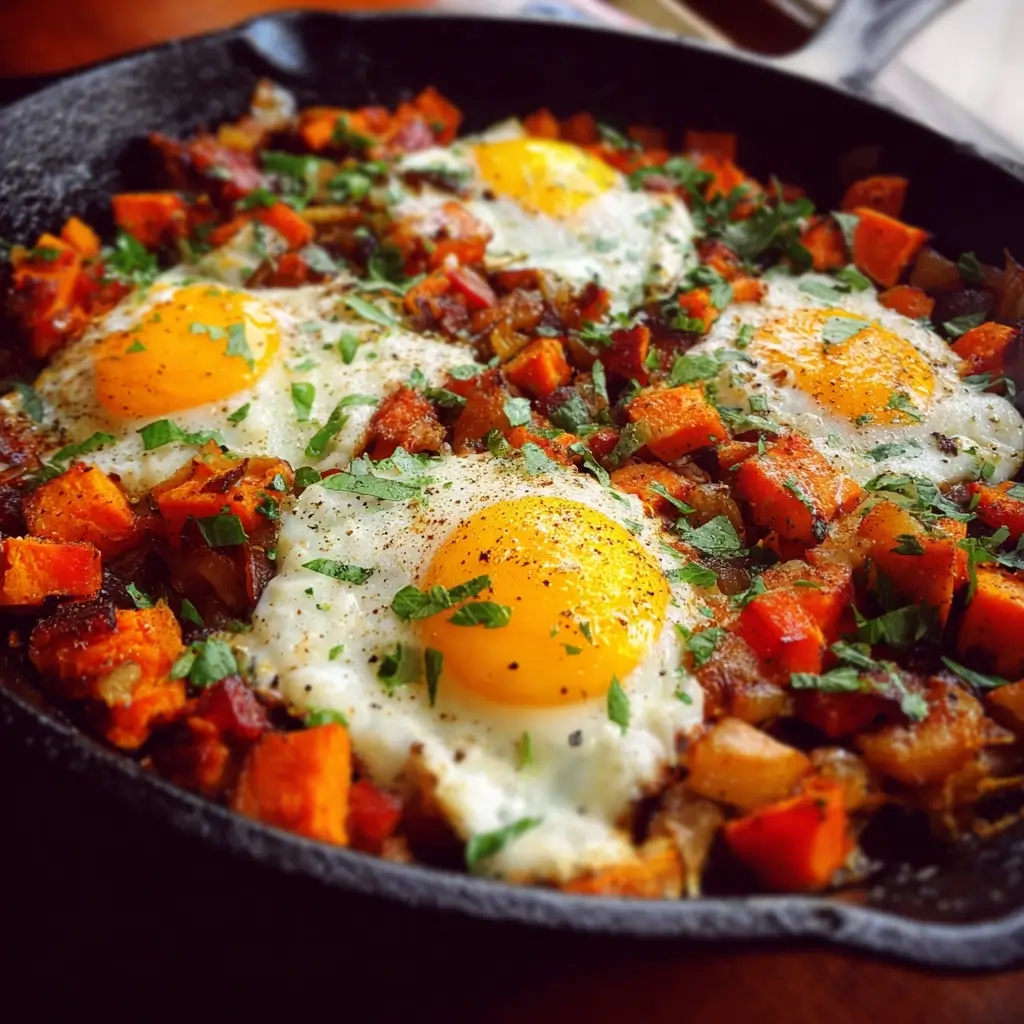There are some recipes that feel like a warm hug in a bowl, and this Quick Sweet Potato Egg Skillet is exactly that for my family. I still remember the first time I made it on a chaotic Tuesday morning. I was staring into the fridge, facing the usual breakfast dilemma: find something fast, something healthy, and something the kids would actually eat without protest. I saw sweet potatoes, a carton of eggs, and an onion, and a lightbulb went off. Twenty minutes later, the kitchen was filled with the incredible aroma of sizzling sweet potatoes, savory spices, and fresh herbs. The vibrant orange of the potatoes contrasted beautifully with the bright white and sunny yellow of the perfectly cooked eggs. When I placed the skillet on the table, my family’s eyes lit up. It was an instant hit. The slight sweetness of the potatoes, the savory depth from the spices, and the rich, runny yolk creating a natural sauce was a combination that won everyone over. It’s since become our go-to for a satisfying breakfast, a quick lunch, and even a “breakfast-for-dinner” night. It’s the kind of simple, wholesome, one-pan wonder that makes you feel like a kitchen superhero, all before 8 AM.
Ingredients
- 2 tablespoons Olive Oil: A quality extra virgin olive oil forms the base for sautéing, adding a subtle, fruity flavor and healthy fats.
- 1 medium Yellow Onion (diced): This aromatic all-star builds the first layer of savory flavor in the skillet.
- 2 cloves Garlic (minced): For that pungent, irresistible aroma and taste that complements the other ingredients perfectly.
- 2 medium Sweet Potatoes (about 1.5 lbs, peeled and diced into ½-inch cubes): The star of the show, providing natural sweetness, a creamy texture, and a wealth of nutrients.
- 1 teaspoon Smoked Paprika: Adds a deep, smoky flavor that beautifully contrasts the sweetness of the potatoes.
- ½ teaspoon Cumin: Lends a warm, earthy note that is essential in a savory hash.
- ¼ teaspoon Red Pepper Flakes (optional): For a gentle kick of heat. Adjust the amount based on your preference for spice.
- ½ teaspoon Salt (or to taste): Enhances all the flavors in the dish.
- ¼ teaspoon Black Pepper (freshly ground): Provides a sharp, pungent counterpoint to the other spices.
- ¼ cup Water or Vegetable Broth: Used to help steam and soften the sweet potatoes, ensuring they cook through evenly.
- 4-6 Large Eggs: The protein-packed topping. The number depends on how many people you’re serving or how hungry you are.
- Fresh Parsley or Cilantro (chopped, for garnish): A final touch of freshness and color that brightens up the entire skillet.
- Avocado (sliced or diced, for serving): Adds a wonderful creaminess and healthy fats.
Instructions
- Heat the Skillet and Sauté Aromatics: Place a large, 10 to 12-inch cast-iron or non-stick skillet over medium-high heat. Add the olive oil. Once the oil is shimmering, add the diced yellow onion. Sauté for 3-4 minutes, stirring occasionally, until the onion becomes soft and translucent. Add the minced garlic and cook for another minute until fragrant, being careful not to let it burn.
- Cook the Sweet Potatoes: Add the diced sweet potatoes to the skillet. Sprinkle them evenly with the smoked paprika, cumin, red pepper flakes (if using), salt, and black pepper. Stir everything together thoroughly to ensure the sweet potato cubes are well-coated in the spices and oil. Allow the potatoes to cook for about 5-7 minutes, stirring only occasionally, to allow them to develop a nice brown crust on one side. This caramelization is key to building flavor.
- Steam for Tenderness: Pour the ¼ cup of water or vegetable broth into the skillet. It will sizzle and create steam immediately. Cover the skillet with a lid and reduce the heat to medium-low. Let the potatoes steam for 8-10 minutes, or until they are fork-tender. The time may vary slightly depending on the exact size of your potato cubes.
- Make Wells for the Eggs: Once the sweet potatoes are tender, remove the lid. Use the back of a spoon to create small wells or indentations in the sweet potato hash. Make one well for each egg you plan to cook. This helps keep the eggs contained as they cook.
- Cook the Eggs: Carefully crack one egg into each well. Season the eggs with a tiny pinch of salt and pepper. Reduce the heat to low, and place the lid back on the skillet. Cook for 4-6 minutes, or until the egg whites are completely set and opaque, but the yolks are still runny to your liking. If you prefer firmer yolks, let them cook for an additional 1-2 minutes.
- Garnish and Serve Immediately: Turn off the heat. Carefully remove the skillet from the stove. Garnish generously with fresh chopped parsley or cilantro. Serve the skillet immediately, directly from the pan, with sliced avocado on top or on the side.
Nutrition Facts
- Servings: 2-3
- Calories per serving: Approximately 380-450 kcal
- High in Vitamin A: The sweet potatoes in this dish are an exceptional source of beta-carotene, which the body converts into Vitamin A. This vitamin is crucial for maintaining healthy vision, supporting the immune system, and promoting cell growth.
- Excellent Source of Protein: With a generous helping of eggs, this skillet provides high-quality protein that is essential for muscle repair, hormone production, and keeping you feeling full and satisfied long after your meal.
- Rich in Dietary Fiber: Both sweet potatoes and onions contribute to the high fiber content of this recipe. Fiber aids in digestion, helps regulate blood sugar levels, and contributes to a feeling of fullness, which can help with weight management.
- Packed with Complex Carbohydrates: Unlike simple sugars that cause energy spikes and crashes, the complex carbohydrates from sweet potatoes provide a slow, steady release of energy, making this an ideal meal to fuel your morning or a post-workout recovery.
- Contains Healthy Fats: The use of olive oil and the optional addition of avocado provide monounsaturated fats. These beneficial fats are known to support heart health by helping to reduce bad cholesterol levels.
Preparation Time
This recipe is designed for speed and efficiency, making it perfect for busy mornings or quick weeknight dinners. The total time from start to finish is approximately 25-30 minutes.
- Preparation Time (5-7 minutes): This includes washing and peeling the sweet potatoes, dicing the onion, and mincing the garlic. Your knife skills will be the biggest factor here.
- Cooking Time (20-23 minutes): This covers the time from sautéing the onions to the eggs being cooked to perfection in the skillet.
How to Serve
This sweet potato egg skillet is a complete meal on its own, but it can also be dressed up with a variety of toppings and sides to suit any palate or occasion. Here are some delicious ways to serve it:
- Straight from the Pan: For a rustic, family-style meal, simply place the hot skillet (on a trivet to protect your table!) in the center of the table and let everyone dig in. It’s communal, easy, and saves on dishes.
- Plated Individually: Scoop a generous portion of the sweet potato hash and eggs onto each plate. This allows for more personalized garnishing.
Topping Suggestions:
- Creamy & Cooling:
- Sliced or Mashed Avocado: A classic pairing that adds healthy fats and a buttery texture.
- A Dollop of Greek Yogurt or Sour Cream: Introduces a tangy element that cuts through the richness of the egg yolks.
- Cheesy & Savory:
- Crumbled Feta or Goat Cheese: The salty, tangy bite of these cheeses is a fantastic contrast to the sweet potatoes.
- Shredded Sharp Cheddar or Monterey Jack: Sprinkle on top while the eggs are cooking to get a delicious, melty cheese pull.
- Spicy & Zesty:
- Your Favorite Hot Sauce: A few dashes of Cholula, Sriracha, or Tabasco can add a wonderful vinegary heat.
- Fresh Salsa or Pico de Gallo: Adds a burst of freshness, acidity, and texture.
- Fresh & Green:
- Chopped Green Onions or Chives: Offer a mild, oniony bite that complements the cooked onions.
- A Handful of Baby Spinach or Arugula: You can either wilt this into the hash at the end or serve it fresh on top for a peppery bite.
Side Dish Pairings:
- Crusty Bread or Toast: Perfect for sopping up the runny egg yolk and any remaining bits in the skillet. Sourdough or whole-grain toast works beautifully.
- Simple Green Salad: A side salad with a light vinaigrette can brighten up the meal and add another serving of vegetables.
- Fresh Fruit: A bowl of mixed berries or sliced melon on the side provides a sweet and refreshing contrast to the savory skillet.
Additional Tips
- Achieve Perfectly Crispy Potatoes: The secret to getting a good crust on your sweet potatoes is a hot pan and not overcrowding it. Make sure your skillet is properly heated before adding the potatoes. Spread them in a single layer and resist the urge to stir them constantly. Letting them sit for a few minutes allows them to brown and caramelize, which builds immense flavor.
- Meal Prep for Even Faster Mornings: You can do most of the prep work ahead of time. Peel and dice the sweet potatoes and onions the night before. Store the diced sweet potatoes in a container of cold water in the fridge to prevent browning, and keep the onions in a separate airtight container. This can cut your morning cook time in half.
- Customize with More Veggies: This skillet is a fantastic base for clearing out your vegetable drawer. Feel free to add a diced bell pepper (any color!), sliced mushrooms, or chopped zucchini. Add heartier vegetables like peppers along with the onions, and quicker-cooking vegetables like zucchini or spinach towards the end of the potato cooking time.
- Experiment with Spices: Don’t be afraid to change up the spice profile. For a different flavor, try using a teaspoon of chili powder for a Tex-Mex feel, or a blend of dried oregano and thyme for a more Mediterranean vibe. A pinch of ground coriander also pairs wonderfully with cumin.
- Boost the Protein: For an even heartier meal, you can add more protein. Consider adding cooked, crumbled ground beef or diced cooked ham to the skillet along with the onions to heat through. For a vegetarian option, stir in a can of rinsed and drained black beans or chickpeas when the potatoes are almost tender.
- Master the Perfect Egg: The key to a perfect “skillet egg” is controlling the heat and using a lid. After cracking the eggs into their wells, immediately cover the pan. The trapped steam will gently cook the top of the eggs (the whites) while the direct heat from below cooks the bottom. Keep a close eye on them to achieve your desired yolk runniness.
- Choose the Right Skillet: A well-seasoned cast-iron skillet is the ideal choice for this recipe. It retains heat incredibly well, which is perfect for searing the potatoes and cooking everything evenly. If you don’t have cast iron, a large, heavy-bottomed non-stick skillet will also work well and makes cleanup easier.
- Don’t Underestimate the Garnish: The final sprinkle of fresh herbs is more than just for looks. Fresh parsley or cilantro adds a burst of bright, clean flavor that cuts through the richness of the dish and elevates it from good to great. A squeeze of fresh lime juice can have a similar brightening effect.
FAQ Section
1. Can I make this Sweet Potato Egg Skillet ahead of time?
Yes, partially. For the best results, you can cook the sweet potato hash (steps 1-3) completely ahead of time. Let it cool and store it in an airtight container in the refrigerator for up to 3 days. When you’re ready to eat, simply reheat the hash in a skillet over medium heat until warmed through, then proceed with making the wells and cooking the eggs fresh. This makes for an incredibly fast and satisfying meal.
2. How do I store and reheat leftovers?
Store any leftovers in an airtight container in the refrigerator for up to 2 days. The yolks will cook through and become firm upon reheating, so the texture will be different. To reheat, you can use a microwave in 30-second intervals until warm. For a better texture, reheat the hash in a skillet over medium-low heat with a splash of water or oil until heated through. You can even chop up the leftover cooked eggs and mix them into the hash.
3. Is this recipe gluten-free and dairy-free?
Yes, as written, this recipe is naturally gluten-free and dairy-free. All the ingredients—vegetables, eggs, oil, and spices—are free from gluten and dairy. If you choose to add cheese as a topping, it will no longer be dairy-free, so be mindful of your dietary needs when considering additions.
4. Can I use regular potatoes instead of sweet potatoes?
Absolutely! Russet, Yukon Gold, or red potatoes are excellent substitutes. The flavor profile will be more savory and less sweet. Note that Russet potatoes may take a few minutes longer to become tender, so adjust the steaming time accordingly. Dice them to a similar ½-inch size for even cooking.
5. My sweet potatoes are taking a very long time to cook. What did I do wrong?
There are two common reasons for this. First, your potato cubes might be too large. Dicing them into a uniform, smaller size (around ½-inch) is key for quick cooking. Second, you may not have used enough liquid or a tight-fitting lid during the steaming step. The steam is crucial for softening the potatoes. If they’re still hard after the initial steaming time, add another tablespoon or two of water, cover, and continue cooking for a few more minutes.
6. What other proteins can I add to this skillet?
This skillet is very versatile. Besides eggs, you can incorporate other proteins to make it even more substantial.
- Meat: Add 1/2 pound of cooked ground beef or turkey, or about 1 cup of diced, cooked ham. Stir it in with the onions to heat through.
- Vegetarian: Add a 15-ounce can of rinsed and drained black beans or chickpeas during the last 5 minutes of the potato cooking time.
- Plant-Based: Crumbled tofu or tempeh can also be browned along with the onions at the beginning.
7. Can I bake this in the oven instead of cooking it on the stovetop?
Yes, you can easily convert this to a baked dish. Use an oven-safe skillet (like cast iron). Follow the stovetop instructions for sautéing the onions and browning the potatoes. Then, instead of steaming on the stove, transfer the skillet to a preheated 400°F (200°C) oven and bake for 15-20 minutes, or until the potatoes are tender. Carefully remove the skillet from the oven, make the wells, crack in the eggs, and return it to the oven for another 5-8 minutes, or until the eggs are cooked to your liking.
8. Why did everything stick to my pan?
Sticking can usually be attributed to a few factors. If you’re not using a non-stick or well-seasoned cast-iron skillet, sticking is more likely. Additionally, make sure your pan and oil are sufficiently hot before adding the ingredients. A hot pan helps create an instant sear that prevents food from sticking. Finally, ensure you’re using enough oil to coat the bottom of the pan and the potatoes. If things start to stick while cooking, a small splash of water or broth can help deglaze the pan.






